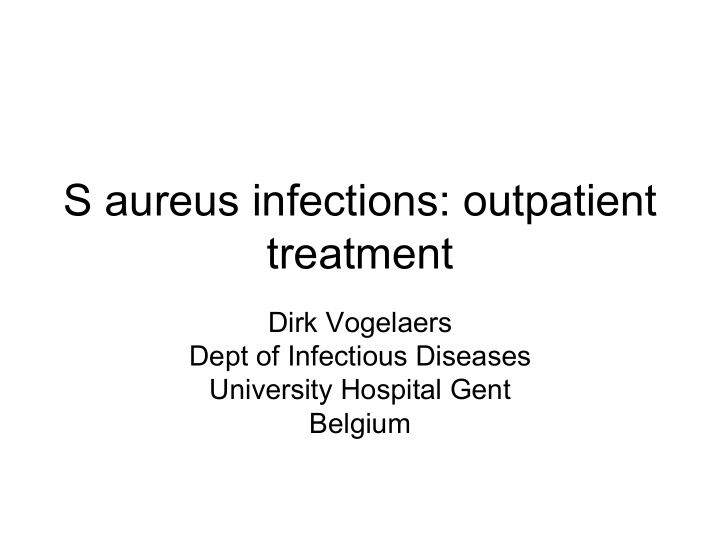



S aureus infections: outpatient treatment Dirk Vogelaers Dept of Infectious Diseases University Hospital Gent Belgium
Intern Med J. 2005 Feb;36(2):142-3
Intern Med J. 2005 Feb;36(2):142-3
Treatment of S aureus infections in the outpatient setting • Consolidation (often sequential) treatment of severe infections with microbiologic documentation after initial hospitalisation • Empiric outpatient treatment of mild to moderate SSTI with a high likelihood of S aureus infection
Sequential treatment after discharge from hospital • Clinical trials on SSTI focus on “complicated” SSTI – Requiring hospitalisation – Requiring surgery • Often “proof of principle” studies required for registration and not offering information on positioning of drugs in treatment algorithms – Daptomycin – Tigecycline • Information on required or optimal duration of therapy lacking
Sequential treatment of documented S aureus infections • MSSA – PRSP in adequate dosing • 4 x 1 g flucloxacillin • MRSA – Teicoplanin IM – Teicoplanin IV 3 x/week – Linezolid po – Cotrimoxazole – Clindamycin
Treatment of S aureus infections in the outpatient setting • Consolidation (often sequential) treatment of severe infections with microbiologic documentation after initial hospitalisation • Empiric outpatient treatment of mild to moderate SSTI with a high likelihood of S aureus infection
Folliculitis
Bullous impetigo Non-bullous impetigo
Antimicrobial therapy in impetigo • Non bullous impetigo (“honey crust”) – Group A streptococci, S aureus • Topical treatment • If extensive, PRSP or cefadroxil • Bullous impetigo – S aureus (phage group II, usually type 71) • PRSP • In IgE mediated allergy doxycycline, minocycline or TMP-SMX
Furuncles and carbuncles • Not necessarily indication for antibiotics – Application of moist heat sufficient treatment for most furuncles • Antibiotics in – Carbuncles – Furuncles with surrounding cellulitis or fever – Furuncle located about the midface → PRSP (250 mg dicloxacillin/6 hrs) → clindamycin 150-300 mg/6 hrs in IgE mediated penicillin allergy • Surgical drainage of large and fluctuant lesions – If < 5 cm diameter without cellulitis or sepsis no indication for antibiotics • Consider MRSA infection after recent hospitalisation
Carbuncle
Cellulitis and Erysipelas involving erysipelas. face.
Extent to cover S aureus? • Erysipelas (“non purulent cellulitis”) – Large proportion to be attributed to group A streptococcus (Bernard. Arch Dermatol 1989; 25: 779-82) – S aureus as important in frequency distribution of pathogens in prospective assessment (microbiol/serology) of 73 pts with clinical (68 % lower limb) erysipelas • 41 % microbiologically documented • 15 % group A strep, 12.5 % group G strep (mostly in men > 50 yrs), 10 % S aureus (Hugo-Persson. Infection 1987; 15: 184-7)
Erysipelas: treatment • 10 d IV (downstep to oral) medium dose penicillin standard treatment based on retrospective studies • Limited evaluation in randomised prospective studies – Roxithro vs. IV peni: efficacy 83% vs 76 %, limited patient population (n=69) (Bernard, Br J Dermatol, 1992, 127: 755-758) – Oral vs. IV peni (Jurup-Rönström, Infection, 1984; 12:390-394) – Antibiotics + predni : double blind, placebo controlled (Bergkvist., Scand J Infect Dis 1987; 25:377-378) Pristinamycine vs peni IV → oral in hospitalised pts with erysipelas • (Bernard, BMJ, 2002; 325) – As effective in open prospective non-inferiority trial – Cure-rate ITT 65 % (90/138) vs. 53 % for penicillin, in protocol-valid pts 81% vs 67 % – Possible superiority of 5 % • Amoxiclav not mentioned in guidelines, but logical in order to cover both GABHS and MSSA – Recommendation to cover S aureus in facial erysipelas (risk of sinus cavernosus thrombophlebitis)
Empiric treatment of mild/moderate infections presumably due to S aureus • Cover most likely pathogens in frequency distribution of microorganisms in particular disease entity – Cellulitis without underlying disease • Group A, B, C and G streptococci, S aureus PRSP and clindamycin as alternative – – < 10 % clindamycin resistance in GABHS and S aureus in Belgium – Cellulitis with underlying disease • Same pathogens + P aeruginosa + Enterobacteriaceae – Amoxiclav – Clinda + FQ2 as alternative • Samples for microbiology warranted (needle puncture through adjacent intact skin or skin biopsy) as more diversity in pathogens involved according to clinical situation/modifying circumstances
Inducible resistance to clindamycin in S aureus • Present both in MSSA and MRSA with geographic variability – 2 % of MRSA / 9 % of MSSA in prospective assessment of causes of SSTI in US emergency depts (Moran NEJM 2006; 355:666-74) – Need for regional information • Clindamycin used in treatment of infections with MRSA isolates possessing inducible resistance (Martinez-Aguilar. Pediatr Infect Dis 2003; 22: 593-8) (Drinkovic. JAC 2001; 48: 315-6) • Clinical failures reported (Siberry. CID 2003; 37: 1257-60)
This figure shows the six phenotypes observed during CLI induction testing of S. aureus by disk diffusion. E 15, ERY disk (15 µg); CC 2, CLI disk (2 µg). Top row: D phenotype (A), D+ phenotype (B), Neg phenotype (C). Bottom row: HD phenotype (D), R phenotype (E), S phenotype (F). See text and Table 1 for descriptions of the phenotypes. J Clin Microbiol. 2005 Apr;43(4):1716-21
Clindamycin in S aureus infections • Recommendation for testing S aureus isolates with potential for inducible clindamycin resistance (isolates resistant to erythromycin but susceptible to clindamycin on initial testing) for inducible resistance by D-zone disk-diffusion testing (CLS M100-S16, 2006) • However, no routine microbiologic sampling in outpatient setting • Regular regional surveillance of MSSA/MRSA → change in guidelines for empirical therapy – treshold for change?
Community-acquired MRSA • High prevalence (59%; 98 % SCC mec type IV; PVL positive) of CA-MRSA (USA300 clone) in prospective study of causes/outcome of SSTI in emergency departments • No association between patient outcomes and susceptibility of pathogen to antimicrobial agents prescribed (although limited followup information) • Most skin abscesses can be cured with adequate drainage alone, even when caused by MRSA (Moran et al. NEJM 2006; 355: 666-74)
GRAYSON NEJM august 17, 2006, 355;5, 724
Recommend
More recommend